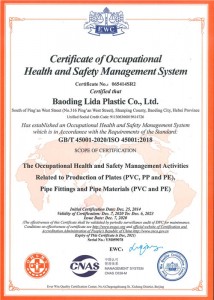Dis . 14, 2024 22:25 Back to list
polyethylene pipe fittings
Understanding Polyethylene Pipe Fittings A Comprehensive Guide
When considering plumbing or irrigation systems, the choice of materials is crucial for ensuring longevity and efficiency. One of the most popular materials in modern pipe systems is polyethylene (PE), known for its versatility, durability, and resistance to corrosion. However, to fully harness the benefits of polyethylene pipes, it’s essential to understand the fittings that connect them.
What Are Polyethylene Pipe Fittings?
Polyethylene pipe fittings are components used to connect sections of polyethylene piping or to connect piping to different systems or components. These fittings play a critical role in creating a sealed, leak-free connection, which is vital in applications ranging from agricultural irrigation to municipal water supply.
Types of Polyethylene Pipe Fittings
1. Couplings Couplings are used to join two sections of pipe together. Available in various sizes, they can be categorized into standard couplings, which connect pipes of the same diameter, and reducer couplings, which connect pipes of different diameters.
2. Elbows Elbows are fittings used to change the direction of flow in a piping system. Common angles for elbows include 45 degrees and 90 degrees, allowing for flexibility in layout without compromising the system’s integrity.
3. Tees Tees are used to create a branch in the pipework. They can connect three sections of pipe and are available in equal or unequal sizes depending on the required flow distribution.
4. Adapters Adapters allow for seamless transitions between polyethylene pipes and other types of piping materials, such as PVC or metal. This adaptability is essential in mixed systems where different materials might be necessary.
5. End Caps End caps are used to seal the end of a pipe, preventing fluid from escaping. They are often used in systems where sections of the pipeline need to be isolated for maintenance or testing.
6. Coupling/Reducer Fittings These are specialized fittings designed for joining pipes of different diameters together, ensuring a smooth transition that minimizes turbulence and pressure loss.
Advantages of Polyethylene Pipe Fittings
polyethylene pipe fittings

1. Durability PE fittings are highly resistant to chemicals, corrosion, and extreme weather conditions. This durability makes them suitable for various applications, including underground installations.
2. Lightweight Compared to metal fittings, polyethylene fittings are lighter, offering ease of installation and transport.
3. Flexibility The flexibility of polyethylene materials allows them to withstand pressure without cracking or breaking, making them ideal for applications where ground movement is a concern.
4. Cost-Effective PE fittings can be more economical than traditional materials, particularly for large-scale projects, due to lower installation and maintenance costs.
5. Environmental Resistance Polyethylene does not leach harmful chemicals into drinking water, making it a safe choice for potable water systems.
Installation Considerations
When installing polyethylene pipe fittings, several factors should be taken into account
- Temperature PE materials can become more flexible in higher temperatures; therefore, it’s crucial to consider ambient conditions during installation.
- Jointing Techniques Depending on the application, different jointing techniques can be used, such as heat fusion, electrofusion, or mechanical fittings. Each method has its own set of advantages and must be selected based on the specific application.
- Support and Anchoring Proper support and anchoring of the pipes and fittings are essential to prevent sagging and stress at the joints, which can lead to leaks over time.
Conclusion
Polyethylene pipe fittings are an integral component in the pipeline infrastructure, offering solutions that enhance the functionality and efficiency of both residential and commercial systems. Understanding the different types of fittings, their advantages, and proper installation techniques can significantly impact the performance of piping systems. As the demand for reliable and safe plumbing solutions continues to rise, polyethylene fittings will undoubtedly play a key role in shaping the future of fluid transport. Whether you are a contractor, engineer, or DIY enthusiast, grasping the importance of these fittings will ensure the success of your projects, ultimately leading to better service delivery in various industries.
-
High-Quality HDPE Sheet | Durable Plastic Panels
NewsAug.06,2025
-
High-Precision PVC Rigid Sheets for Vacuum Forming | AI-Optimized
NewsAug.05,2025
-
Durable PVC-M Water Supply Pipes | 60-Year Life
NewsAug.04,2025
-
Premium HDPE Water Supply Pipes: Durable & Leak-Proof
NewsAug.03,2025
-
Premium PVC-M Water Supply Pipe - Durable & Efficient
NewsAug.02,2025
-
HDPE Drainage & Irrigation Pipe - Durable, Efficient Solutions
NewsAug.01,2025

